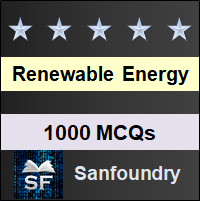
Renewable Energy Multiple Choice Questions Highlights
- 1000+ Multiple Choice Questions & Answers (MCQs) in Renewable Energy with a detailed explanation of every question.- These MCQs cover theoretical concepts, true-false(T/F) statements, fill-in-the-blanks and match the following style statements.
- These MCQs also cover numericals as well as diagram oriented MCQs.
- These MCQs are organized chapterwise and each Chapter is futher organized topicwise.
- Every MCQ set focuses on a specific topic of a given Chapter in Renewable Energy Subject.
Who should Practice Renewable Energy MCQs?
– Students who are preparing for college tests and exams such as mid-term tests and semester tests on Renewable Energy.- Students who are preparing for Online/Offline Tests/Contests in Renewable Energy.
– Students who wish to sharpen their knowledge of Renewable Energy Subject.
- Anyone preparing for Aptitude test in Renewable Energy.
- Anyone preparing for interviews (campus/off-campus interviews, walk-in interview and company interviews).
- Anyone preparing for entrance examinations and other competitive examinations.
- All - Experienced, Freshers and College / School Students.
Renewable Energy Chapters
Here's the list of chapters on the "Renewable Energy" subject covering 100+ topics. You can practice the MCQs chapter by chapter starting from the 1st chapter or you can jump to any chapter of your choice.- Fundamentals of Energy
- Basics of Solar Energy
- Solar Thermal System
- Wind Energy
- Biomass Energy
- Geothermal Energy
- Ocean Energy
- Emerging Technologies
1. Fundamentals of Energy
The section contains multiple choice questions and answers on energy resources classification, conventional energy sources advantages and disadvantages, non-conventional energy sources basics and salient features, energy environmental aspects, world energy status and also energy scenario in india.
2. Basics of Solar Energy
The section contains questions and answers on sun and earth radiation spectrums, extraterrestrial and terrestrial radiations, solar radiation depletion and measurements, solar time, solar radiation geometry, solar day length, empirical equations, diffuse and beam radiations on horizontal surface.
3. Solar Thermal System
The section contains MCQs on solar collectors, solar water heater, solar passive space, solar refrigeration, air conditioning systems, solar cookers, solar furnaces and dryer, solar distillation and solar thermo mechanical systems.
4. Wind Energy
The section contains multiple choice questions and answers on winds origin and nature, wind turbine siting, wind power applications, wind turbine aerodynamics, types and construction, wind energy conversion systems, wind speed effects, grid condition and wind energy storage.
5. Biomass Energy
The section contains questions and answers on solar radiation, photosynthesis process, biomass usable forms, composition and fuel properties, biomass resources and conversion technologies, biomass gasification and biogas production.
6. Geothermal Energy
The section contains MCQs on geothermal energy applications, origin and distribution, geothermal resources types and environmental consideration.
|
|
|
7. Ocean Energy
The section contains multiple choice questions and answers on tidal and ocean thermal energy.
|
|
|
8. Emerging Technologies
The section contains questions and answers on hydrogen energy.
|
|
|
Wish you the best in your endeavor to learn and master Renewable Energy!
